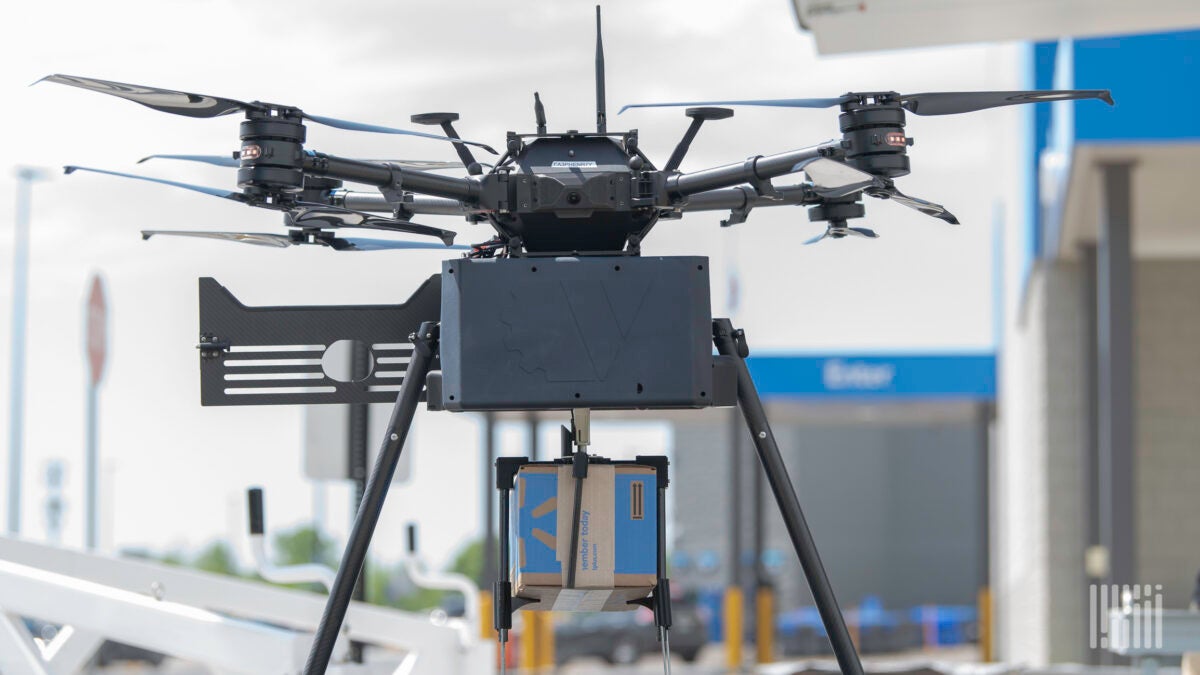When you’re the world’s largest retailer, customers expect a premium delivery experience — without paying a premium. But being the biggest seller on the planet also comes with a few perks.
Walmart (NYSE: WMT) has a war chest of institutional funding at its disposal, and its massive scale allows it to spend that money on any number of speculative ventures without undertaking potentially disastrous risk. Already, the company has experimented with solutions like drone delivery, food delivery robots and fully autonomous box trucks. A new patent, though, seeks to combine all three.
The patent, filed last week with the U.S. Patent and Trademark Office, describes a solution that combines driverless technology with delivery drones and robots. Under the proposal, Walmart would use automated guided vehicles (AGVs) that follow a predetermined route. But if they run into any obstacles, they would automatically release a drone to complete the delivery.
“We’re continuously exploring how emerging technologies may shape future shopping experiences and are testing new ideas all the time. Some ideas become products or services that make it to customers. And some we test, iterate and learn from,” Walmart said in an email statement to Modern Shipper.
Watch: Delivering everything with drones
The patent filing described drones as the “back-up mechanism” in cases in which deliveries using AGVs don’t go as planned.
“Recently, efforts have been made to deploy autonomous ground vehicles to complete deliveries to customers. The use of autonomous ground vehicles, however, presents its own challenges,” the patent reads. “More specifically, autonomous ground vehicles will often encounter obstacles that may prevent them from completing the delivery, such as, for example, motor vehicles, people, animals, road constructions, curbs and closed gates.”
The robots would be equipped with one or more sensors — the patent mentions laser, ultrasound, optical and infrared sensors as potential options. When those sensors determine that the AGV has been stopped by an obstacle, in certain cases, a drone mounted on top of the robot will fly the rest of the route.
Those include situations in which the AGV is stopped and does not have enough battery power, the obstacle does not move within a given amount of time, the system cannot find an alternative ground-based route, or the AGV will not arrive by the scheduled delivery time.
Related:
Read: Walmart kicks fulfillment into high gear with next-generation centers
Read: Walmart and DroneUp expanding drone delivery to 6 states, 4 million people
In any of these cases, the system would automatically attempt to calculate a new delivery route for the robot, creating one for the drone if no alternative exists. Then, the drone would launch from the top of the robot, secure the package from the robot’s storage area using a grabbing mechanism, and travel to the customer’s location to make the drop-off.
“For example, the AGV might get stuck at the gate in front of a customer’s residence,” the patent suggested. “So, the AGV could travel all the way to the gate, and the UAV [unmanned aerial vehicle] can then grab the package and deliver it to the residence.”
Walmart’s patent resembles one filed by Amazon (NASDAQ: AMZN) last year. Amazon’s version proposes deploying driverless robots from last-mile delivery vans. In this case, the van would be outfitted with sensors that direct the robot, rather than their being mounted on the robot itself.
Walmart’s combined robot and drone delivery solution would draw on technology it has been testing through several partnerships. In June 2021, the retailer announced its investment in DroneUp. That partnership began as a drone delivery pilot out of a Walmart store in Northwest Arkansas, but in May, the companies expanded the service to six states and 4 million people.

More recently, in June, Walmart partnered on robot delivery with Serve Robotics, a spinoff of Uber-backed Postmates. So far, that service has been limited to Walmart’s hometown of Bentonville, Arkansas. Serve hit a major milestone back in January, when it completed the first-ever commercial deliveries using autonomous robots with zero human interaction.
Walmart has also been testing self-driving technology on larger vehicles. The retailer has launched several autonomous trucking pilots through partnerships with firms like Gatik, Argo AI and General Motors subsidiary Cruise.
If the solution outlined in last week’s patent filing comes to fruition, it would effectively combine all of those technologies for the first time. As it stands, plenty of firms have experimented with robot, drone and driverless deliveries — but none has managed to successfully integrate all three.
You may also like:
Walmart is bringing robots to all 42 regional distribution centers
Bloated inventories hit Walmart, Target and other retailers’ profits, trucking demand












In the south, is called skeet shooting with presents
In the south, is called skeet shooting with presents